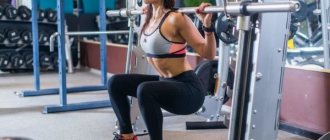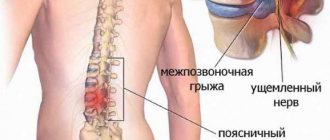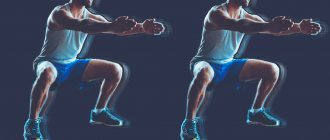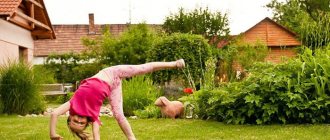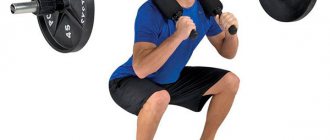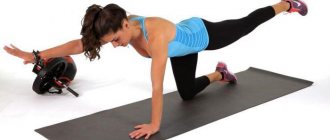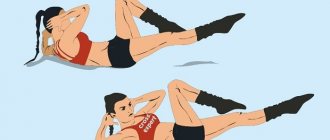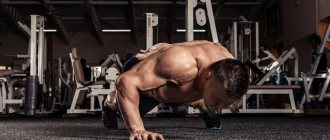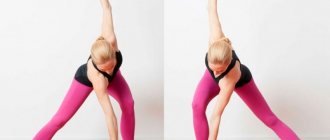Share:
Single-leg squats (pistol squats) are an unusual, but quite effective leg exercise with which you can diversify your quadriceps training, as well as improve your coordination and functionality, observing the technique. In terms of biomechanics, this exercise is almost similar to classic squats, but for some athletes it is much more difficult to perform. Today we will tell you how to learn how to squat on one leg correctly.
We will also touch upon the following aspects of interest to us:
- What are the benefits of squats on one leg?
- Pros and cons of this exercise;
- Types and techniques of squats on one leg.
Single Leg Squats: Pros and Cons
Single leg squats are a strength training exercise that was used by old school strongmen. The movement has become popular again thanks to CrossFit, where it is used as one of the gymnastic elements. The main benefit of the pistol squat is that the entire load falls on one leg. This allows you to provide a powerful load even when working without weights.
Benefits of single leg squats:
- A powerful load on the buttocks, quadriceps and hamstrings.
- Involvement of a large number of muscle fibers (including stabilizer muscles).
- Development of balance.
- There is a complete absence of compression load on the spine, which is why the movement is excellent for gaining weight for people with injuries.
- The ability to perform the exercise in any conditions and without sports equipment.
Main disadvantages:
- They require certain physical preparation and are not suitable for beginners (muscles often do not allow for full squats on one leg).
- Creates increased stress on the knee joint.
- The risks of injury are higher than with other leg exercises.
Knees and toes[edit | edit code]
Many athletes who perform pistol training are afraid for the health of their knees. It is possible to get injured while performing progressively advanced calisthenics exercises, but the same is true for any type of training program. The more advanced the training program, the higher the risk.
Whether you're training with free weights, practicing calisthenics, or doing triathlons, avoiding injury requires following the same rules: regular training, slowly increasing intensity, respecting your own body.
When performing technical exercises, do not rush to move on to their more complicated varieties and, most importantly, train in moderation. This will allow you to easily learn how to do the pistol and include it in your training program. This exercise is designed to strengthen your hips, knees and ankles.
It's important to remember this: Strength training strengthens connective tissue, but ligaments, tendons, and cartilage may not keep up with muscle growth. It is necessary to move on to heavy exercise gradually, over months, even years. Push the boundaries of what is possible, but don't forget that they exist. Don't try to move on to a full-fledged "pistol" without laying the foundation for this.
What muscles work
Single leg squats work almost all the muscles in your legs. The main burden falls on:
- Quadriceps.
- Gluteal (mostly large).
- Biceps femoris.
- Calf muscles.
- Leading.
Also, work in static mode , which stabilize the body.
Technique for performing the pistol exercise at a support
To master the movement safely, it is best to start working with support. It will allow you to fix the position of the body and avoid falling in case of loss of balance or muscle fatigue. It is extremely important that the support is stable.
Technique:
- Stand at a support and grab it with your hand. The back is straight, feet shoulder-width apart.
- Begin to bend your right leg, slowly lowering yourself down. Gradually move your left leg forward without touching the floor.
- Pause for 0.5 seconds and return to the starting position in the same order.
When performing it, it is important to ensure that the force is performed with the leg and not the arm. In this case, the benefit of the pistol will be noticeable.
Technique for performing squats on one leg without support
This is a classic version of a 1-leg squat that does not require support.
Technique:
- Stand straight with your feet shoulder-width apart.
- Begin to lower yourself slowly, bending one leg at the knee.
- You can cross your arms over your chest or put them forward if this helps you maintain your balance.
- Place your other leg forward so that it does not touch the floor.
It is also important to do the pistol with a straight back. Without support, especially if additional weights are used, the back may become round. A slight bend in the back is acceptable, but only the upper part of the body does not “fall” forward.
Tiger shrimp squats[edit | edit code]
You can add intensity to the previous exercise by standing on a hill. In this case, the knee of the second leg acquires the ability to fall below the foot of the supporting leg, and tiger shrimp squats increase the amplitude of movement. But it’s easier to make a “pistol” in this version.
For this type of squats, you will need, among other things, considerable stretching. As you begin to lower, allow your knee to move below the level of the object you are standing on, allowing it to move slightly forward.
Smith Single Leg Squats
The Smith Single Leg Drop is the only exercise where it is safe to use heavy weights. This version is also good for beginners (with an empty bar) or athletes who have poor balance.
Technique:
- Place the bar on your shoulders and stand straight with your feet shoulder-width apart. The body should fall down perpendicular to the floor and without tilting.
- Begin to sit down, bending one leg at the elbow. Pull the second one forward, as in a regular pistol.
- Without pausing, return to the starting position at a moderate pace.
Taking into account the load on the back, the main difference from techniques without weight and support is the position of the back. If in classic versions a slight rounding of the back is allowed, then when lifting weights on the shoulders this will be considered a mistake.
Balance of power[edit | edit code]
Of course, maintaining balance while doing a pistol is not that easy, but the two main reasons for not being able to do this exercise are insufficient strength and/or stretching. Often one or the other may be lacking (although guys often blame insufficient stretching when in fact they lack strength). You can check whether you are able to perform a repetition with a full range of motion by grabbing something with your hands (a pole, a door frame, gymnastic rings, etc.) and trying to squat down. If you succeed, then you have sufficient stretch.
The “pistol” is effective due to the even distribution of effort across different muscle groups: the more you strain one, the more you have to strain the other to compensate. If you overexert your leg or abdominal muscles, you won’t be able to use the pistol. Those who think their only problem is not stretching enough are missing the whole picture. Often the reason for the inability to perform the pistol and bridge is the same: excessive tension. To keep the other leg extended forward, the quadriceps and hip flexors must be strong enough to compensate for the tightness of the Achilles tendon and psoas muscles. It is not necessary to keep your leg parallel to the ground the entire time, but the heel of the other leg should not touch the ground during the exercise. To do this, you also need to have strong abdominal and pelvic muscles.
Theoretically, a person who is able to perform a full range of barbell squats with a weight equal to his own body weight should be able to do a pistol squat. In reality, everything is different: the pistol requires strong abdominal muscles and good coordination, as well as the habit of performing this particular type of squats. Therefore, being able to squat with your own weight on your shoulders does not guarantee that you will be able to perform a pistol. I, like anyone else, had to spend a lot of time to understand exactly how to do this exercise. If, when you look at me, it seems to you that the “pistol” is simple, it is only because I have been practicing it for more than ten years.
The key to successful bodyweight training is using the muscles of your entire body to perform any exercise, and especially the pistol. Here you will need to tense literally every muscle.
As a rule, when beginners try to do a pistol, they are unable to properly extend their other leg in front of them. This is normal: try to squeeze as much as possible out of the quadriceps of your extended leg, helping yourself with your body muscles. In order to tighten them more, you can stretch your arms in front of you and squeeze your palms nested into each other (it is not necessary to fold them in the shape of a pistol). However, some may find it more convenient to squat with their arms spread out. One way or another, when rising from the bottom point, tighten your abs like this. as if you were preparing to take a blow to the stomach.
Free weight option
Of the free weights, the most convenient equipment is the kettlebell. You can press it to your chest without losing your balance. A dumbbell is also suitable for this, but due to its shape, holding it becomes less comfortable.
Features of working with different projectiles:
- Kettlebell – you can use very large weights, hold it comfortably (with your palms on the sides of the apparatus), and do not interfere with balance. The only negative is that it is difficult to regulate the step in increasing weight. 20 exercises with kettlebells →
- A dumbbell is a less convenient option, but allows you to adjust the step by 1-2 kg, which simplifies the progression of the load. Exercises with dumbbells here →
- Sandbag is a good option due to the “streamlined” nature of the bag. Allows you to evenly distribute weight on your shoulders and perform movements without losing balance. The best choice for working with very heavy weights. Read more about what sandbag is →
- The barbell disc is convenient because it can be held with outstretched arms, which helps maintain balance. However, in this position, the shoulder and abdominal muscles are more heavily loaded. And also read: exercises with a barbell disc →
The weight of the equipment must be selected so that a set of 6-8 repetitions can be performed on each leg. Performing more than 10 repetitions per leg is considered less effective, since it does not provide tangible benefits, but puts much more strain on the knee joint.
Exercise options
Many people believe that this exercise has only one form of execution. This opinion is wrong. We would like to offer you the following squat options.
Partial squats, suitable for training
To perform this exercise, additional support under the “fifth” fulcrum is in the form of a chair, a wooden box 30-35 cm high, a bench, a medicine ball or another ball. The squat is performed until your buttocks touch the surface of the support. Using balls helps “cushion” the body into an upright position.
With support, leg under you
Use any hard surface or wall bars as support. Stand facing the support or sideways. Hold the support with your hands and squat. Raise your non-working leg slightly off the floor in a squat. You can step on it on the way up.
Using support
- The support is located in front of you. In such cases, an open door or door frame is used. Stand one step away from the support, facing it. Hold the door on both sides by the handles. Hold the frame with both hands at the level of your lower ribs. You start squatting. This is how squats are performed on one leg with support between the legs.
- Side support. Support – wall, crossbar of a Swedish ladder, exercise machine stand, cabinet. Stand sideways to her. The working leg is located closer to the support. Resist or hold on to it with your hand. Squat.
- Support behind your back. A cabinet or wall will serve as support. Stand with your back to her. You begin to squat, sliding your back along the support.
On a wooden box or box
Place your working leg a few centimeters from the edge of the box/box. The free leg hangs above the floor. Squat, lifting your non-working leg.
Without support
Perfect execution. With your foot on the floor, without any support, perform deep squats.
With a slight weight in your hands
It is easier to perform the exercise with dumbbells. in this case, the arms will be located along the body.
The projectile in front of you with outstretched arms is also a rather difficult exercise. This exercise uses dumbbells, a body bar, a fitball, and a bar. When performing squats, it is prohibited for the arms to be at different levels or for the apparatus to wobble.
With a barbell
There are two variations of the single leg barbell squat: barbell on your shoulders and barbell overhead. Each of them is sufficient to perform. In addition to your weight, you also need to hold additional weight on your shoulders or with outstretched arms above you. Hold the barbell with both hands and very carefully squat with it. A simplified version of squats with a barbell on the shoulders is performed in a Smith machine.
With a weight
The working equipment will be a small weight kettlebell. You need to hold it in front of you so that it does not hang over your free leg.
On a kettlebell
You need to choose shoes that will not slip on such a surface. If you manage to maintain balance on this apparatus, start squatting, remembering to keep your non-working leg straight.
On a weighted kettlebell
An extra-difficult task - you need to squat on a kettlebell while holding another kettlebell in your hands or holding a barbell on your shoulders.
How to learn to do a pistol: introduction exercises
The main way to learn the pistol squat is to perform the movement using a simplified technique. This allows you to get used to the motor pattern of the exercise and gradually strengthen the muscles.
Leading exercises and techniques:
- Air squats or weighted squats.
- Partial squats on one leg while holding the support (in a shortened amplitude).
- Supported squats slowing down for 2 seconds at the bottom.
- Full squats while holding support.
"Pistol" with a counterweight[edit | edit code]
This is one of those rare exercises where using extra weight can make it easier. If you pick up a dumbbell or kettlebell, this will help you maintain your balance by pulling your body forward. In this regard, it is somewhat reminiscent of the previous exercise, in which a partner helps you perform the exercise with full amplitude. Start with 5-7 kilograms and try to reduce the weight of the counterweight over time. Gradually you will learn to perform the pistol exercise without additional weights.
Recommendations
- Never do a movement at the beginning of a workout. To safely perform pistol training, warming up alone may not be enough, so it is better to do it after other exercises.
- The multi-repetition mode should only be used when working without weights.
- To progress, it is enough to perform 3-5 approaches per week.
- The number of movements on each leg should be the same.
When working with weights, increased stress is placed on the back, especially the lower back. Therefore, before performing it, it is recommended to do 1-2 warm-up sets of hyperextension.
Hand position[edit | edit code]
Manipulation of the center of gravity plays an important role in bodyweight training to increase or decrease the difficulty of the exercise. In one-arm push-ups, this is achieved by placing your feet in a narrower or wider position. Do you want to complicate the “pistol”? Try to learn how to squat with your arms behind your back. While you are still learning how to do the exercise, it is better to stretch your arms in front of you.
In this position, the weight is distributed more evenly, the load on the muscles is reduced and it becomes easier to maintain balance. To do this, you can try holding on to your toes (with the bonus of a greater stretch, which will be useful for many).
Once you've learned how to do a few pistol squats, try doing the exercise with your hands on your shoulders, head, or, even more difficult, behind your back.


